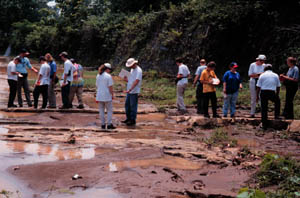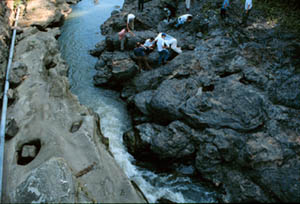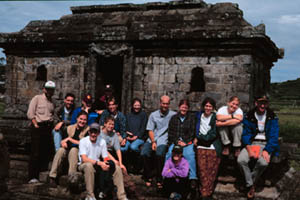

Oberlin Students on the (Plate) Edge:
Indonesian Geology over Winter Term
By Bruce Simonson
A chance meeting with Carl Jacobson, director of the Oberlin Shansi Memorial Association, on the sidewalks of Oberlin led to the biggest project yet a field trip to the Indonesian island of Java. Shansi had cosponsored a 1995 Winter Term field trip to China focused on land use. I asked Carl if the association might be interested in cosponsoring a Winter Term field trip focused on geology, and he suggested Indonesia. No problem there: Indonesia is a classic field area in geological circles.
Why Indonesia Is Interesting to Geologists
Indonesia first made geological headlines in 1883 when the volcano Krakatau erupted, causing a tsunami that caused an estimated 40,000 deaths locally and three years of cooler temperatures globally. Indonesian volcanoes subsequently became some of the best studied in the world, and other geological features of Indonesia are equally renowned.
For example, the well-developed karst terrain of Java is famous among cavers, and the northeastern coast of Sumatra is a classic coal swamp. The effort to predict volcanic eruptions remains a high priority.
Indonesia is the fourth most populous nation on earth, yet harbors the world's most active volcanoes. Gunung Merapi (Mountain of Red Fire in English) is widely believed to be the most dangerous volcano on earth, and it is right next to Yogyakarta. The Shansi reps live and work in "Yogya" at Gadjah Mada University. Joining forces with Shansi to cosponsor a Winter Term project seemed natural to me.
My main concern was leading a trip to a place I'd never seen until fate again intervened. The day Carl and I met to talk about a possible trip to Indonesia, Scott Hassler '82 (one of my former students and my current collaborator in research on impact spherules) happened to be in town. Scott had visited Indonesia in 1985, so I asked him to join us at the meeting. Carl invited him to participate in the trip, and Scott ultimately became co-leader.
Scott's participation was critical to the success of the trip. Scott was able to travel to Indonesia in July 1997. In just two weeks, he made key contacts and scouted sites from Jakarta at the west end of Java to Bali, the next island to the east. Assured that there was plenty of geology to see, we then decided to limit our field trip to central Java.
The Trip Gets Under Way
While he was on Java, Scott stopped at Gadjah Mada University in search of local geological expertise. Three of the people he met there did the most to make the trip a success: Totok Sudibyakto, director of the Research Center for Natural Disasters, Tono Rahardjo of the Department of Geological Engineering, and Eddy Pursubaryanto of the Department of English.
Totok and Tono escorted Scott to sites where the products of important geological processes were well displayed, then helped with our logistical arrangements for the following January. Eddy was in Oberlin during the 1997 fall semester, got to know many of the students taking the Winter Term trip, and helped make the final arrangements. One or more of these three men accompanied us every single day we were on Java, and we would not have seen a fraction of what we saw without their assistance.
Thanks to generous financial support from Shansi, geology alumni, and the Winter Term Committee, we managed to keep the trip affordable; each of the students paid less than half of what the trip really cost. The applications poured in, and I selected 12 upper-level geomajors as participants.
With Eddy's help, we arranged to stay at a hotel in downtown Yogya and reserved vans for the field trips. Associate Shansi Director Deborah Cocco was also a big help. Having taken many trips to Yogya on Shansi business, she told the students what to expect and made our travel arrangements.
When the day arrived, we met in the Los Angeles airport and flew as a group to Yogya. Winarto, another member of the Gadjah Mada English faculty who spent time in Oberlin in 1997 and helped with our trip, greeted us. He urged us to get a few hours sleep before we went to the all-night wayang kulit (shadow puppet show) at the Sultan's Palace.
Because we arrived at the start of Ramadan, the Islamic holy month, only one show took place during our entire trip. Eddy rated this puppeteer a superstar, so we went to the performance, though we were dead tired. We had been on the road continuously for more than 20 hours and were now on the opposite side of the earth. We enjoyed the first part of the performance, but returned to our hotel in a couple of hours.
After using Sunday to acclimate to our new surroundings paying the first of many visits to the busy street market in Yogya we spent Monday at Gadjah Mada University. In the morning we toured the facilities including remote-sensing, seismic-monitoring, and geological laboratories and the anthropological museum. In the afternoon Totok, Tono, and other faculty who were our guides for the trip gave presentations on the geology of Java and the attendant hazards.
The Field Studies
The following day we began our field studies with a day trip to Merapi volcano to see geological deposits and the societal impacts of volcanic processes. To appreciate the risk to those living on Merapi's flanks, we visited a valley that has been the site of repeated lahars and nuées ardentes glowing avalanches.
Volcanologists have borrowed the word lahar from the Javanese tongue to describe warm slurries of water, mud, and gravel that often flow down volcanic valleys in wet climates such as Indonesia. They damage property in the process; in the valley, we saw people digging out a bridge that cost over a million dollars to build. Debris from a lahar had buried the bridge within two weeks of its opening in 1996.
Nuées ardentes are even more hazardous, and Eddy took us to the house where one claimed the lives of two of his friends in 1994. To counter these ongoing threats the government has surrounded Merapi volcano with a network of volcanological observatories; we visited one of them.
Most of the days that followed fit a similar mold. We got in the van each morning, spent the day visiting interesting sites, and returned to our hotel in Yogya in the evening. Among the many geological wonders we saw were:
 |
|
|||||
|
||||||
|
|
 |
|||||
|
||||||
|
|
||||||
 |
||||||
|
||||||
|
||||||
|
||||||
|
Students listen to a geomorphologist from the
Research Center for Natural Disasters at Gadjah Mada University
explain the formation of caves in Gunung Sewu ("Thousand Hills")
Plateau southeast of Yogyakarta.
|
||||||
Cultural Sites, Too
We took advantage of our time in central Java to visit several sites of great cultural and historical significance that reflect Java's cosmopolitan religious heritage. The largest temple at the first site we visited, Prambanan, is dedicated to the Hindu god Shiva. It also has large temples to Brahma and Vishnu and originally had some 228 smaller structures, according to our guide. Workers have reconstructed the larger temples since Scott visited the site in 1985, and now they have begun to reconstruct the smaller structures.
 |
The largest Buddhist site we visited, Borobodur,
was a sprawling edifice featuring scores of bell-shaped domes
made of carved lava rocks, each containing a statue of the Buddha.
As at Prambanan, extensive restoration and landscaping has been
done since the '80s, and plans are now afoot to build a resort
hotel nearby. These sites and several smaller ones we visited
date back a thousand years or more and feature walls covered with
intricate carvings that tell classic stories such as the Ramayana.
|
|||
| We also toured the Sultan's Palace in Yogyakarta. Besides shadow puppet plays, the palace has extensive displays on the history of the line of sultans who have ruled Yogya, and it is still the cultural hub of central Java. I was intrigued to learn that the Sultan's Palace is known as the Kraton. To a geologist, the word craton means a stable central region found on every continent that contains the oldest rocks. | ||||
|
|
||||
No Hard Rain
Two things we did not see on our trip impressed me. The first was a good hard rain. January is part of the rainy season in Indonesia, yet we saw only a few brief showers during our entire stay. Scott and I laid out a schedule that was fairly open, anticipating some rainouts, but we didn't lose a single day to rain. This was another manifestation of the intense El Niño season in Indonesia, yet we saw only a few brief showers during our entire stay.
The second thing we missed was an active eruption. Despite its reputation, Merapi declined to show us a single, tangible sign of activity during our visit. We even traveled up the flank to the observatory to view Merapi on a moonless night, but we didn't see the telltale reddish glow that would indicate the presence of lava near the summit. I suspect the students and I did not heed Eddy's advice to be patient and ask the volcano respectfully for such favors.
I think we achieved our primary aim, to give students a firsthand look at many different geological features and processes that aren't available in Ohio. The trip also reconfirmed two of my long-standing beliefs. The first is in the importance of in-country contacts for this sort of international endeavor. The key to this trip's success was Scott's making contact with the people at Gadjah Mada University, and we are greatly indebted to them for all the help they gave us.
Finally, the trip reconfirmed my faith in Oberlin students. All the students stayed engaged intellectually and soaked up plenty from the geological phenomena we saw. They also had many positive cultural experiences and very few negative ones. The students interacted with the people on the streets of Yogya, spent time at the temples, got an up-close look at the workings of the largest academic institution in Indonesia, and developed a taste for the delicious cuisine.
All in all, the students did a good job of adapting to a different culture in a short period of time. I hope the same can be said of me, and I hope we can continue to offer field experiences like this in future Winter Terms. While we were there, no overt signs of the political unrest that was brewing were visible, except the instability of the currency. The social upheaval that is now making headlines did not affect on our trip although it has led to the postponement of a second trip being organized by theater professor Roger Copeland. It is also having a profound effect on the Shansi reps we met while we were there, but that is another story.
The most recent update was Wednesday, 02/27/2002